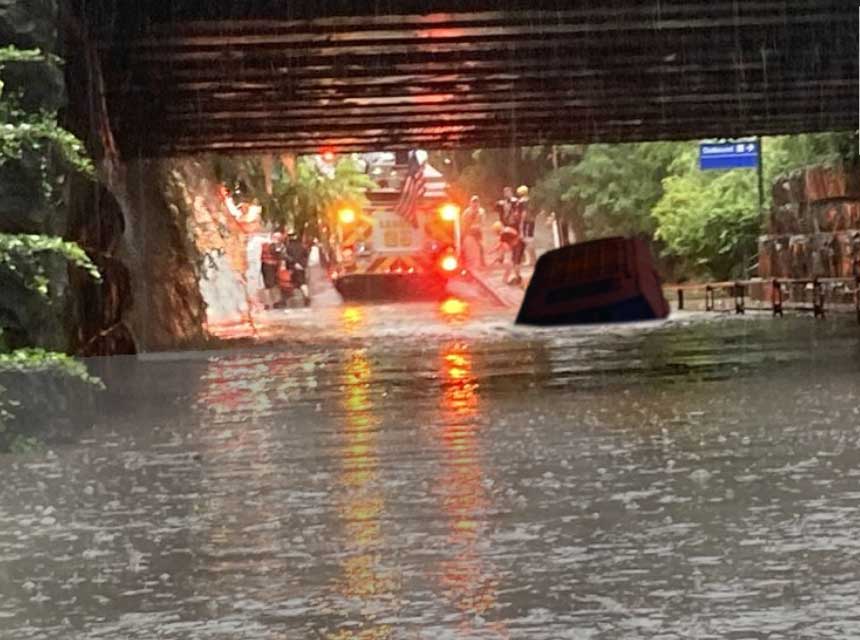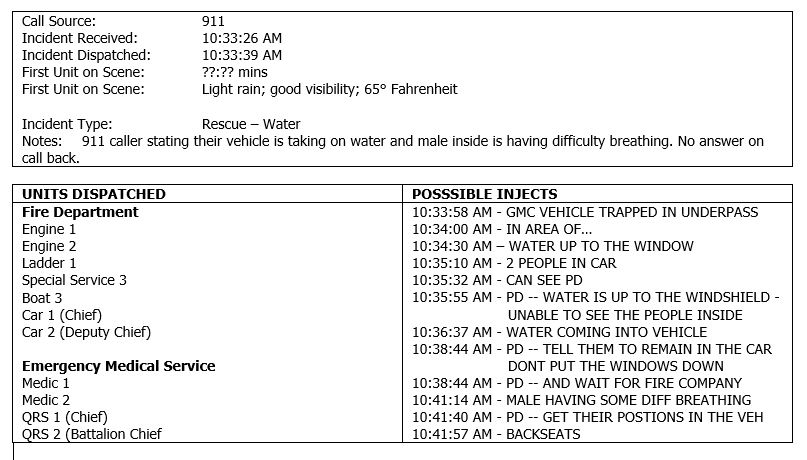
Water Rescue as the First-Due Company Awaiting Specialty Resources
By Arman J. Force and David J. Staffieri
This training module focuses on the hidden dangers of water rescue and the dynamics that affect a rescue. The aim of this is to provide the basics for you to expand your training arsenal to your district and your company’s target hazards. This is merely a springboard for suggested training guidelines and materials you can use for your drills surrounding a water rescue. The hope is to improve firefighter safety and survival to give your crew a better understanding of the dynamics surrounding them while operating at a water rescue incident.
The “Hidden Dangers” series from SimsUshare integrates a discussion about a scenario with interactive simulations you can adapt and use in your training.
RELATED FIREFIGHTER TRAINING
Swiftwater Rescue: Are We Ready?
Training Minutes: Water Rescue Recon
The Incident
In this scenario, we will look at a flooding event at an underpass. A motorist has become stranded, necessitating a water rescue. As the first-due company awaiting specialized resources, it’s incumbent everyone operating on the fireground understand the inherent complexity of the incident.

The initial image in the simulation above shows arriving conditions. Note that it’s a railroad underpass; the height of the underpass is thirteen feet. During the incident there is approximately seven feet of travel distance from the water line to the bridge, which equals approximately six feet of water. The overall width of the underpass is approximately, 24 feet, with four feet being the width of the sidewalk. In addition, the sidewalk is raised four feet from the center/lowest portion of the underpass. One of the immediate challenges this scenario presents is access. A railroad underpass offers only two access points. In this case, since you are unable to traverse the underpass, it would take approximately five minutes to get to the other side, a 1.6-mile trip. Note that there are electrical conduits that run along the ceiling of underpass.
First-Arriving Factors
First-arriving units find a four-door SUV about three-quarters submerged with two occupants reported trapped. There are three factors that are important to prioritize during the first minutes after arriving.
- Logistics:
- What resources are responding?
- Are additional resources needed?
- Determine the best access for rescuers and incoming apparatus.
- Water Dynamics
- Is the water line rising or falling?
- Determine the rate at which the car is sinking.
- Safety
- Are there electrical lines in play?
- Are there storm drains or manholes?
- Are the occupants in immediate danger?
- Verify and determine level of entrapment (if possible).
The answer to these questions will determine how the incident progresses over the duration of the call. A thorough knowledge of your first due will expediate the speed at which these decisions will be made. On the surface, this incident presents only two challenges: the patients in a sinking vehicle and access to the vehicle, both of which are visible life safety hazards. However, those familiar with such incidents will be keen to point out the inherent complexity and dangers that face all first responders. How can we teach those effecting the rescue the dangers they may face at future calls? How do we give them the tools and knowledge they need to understand their limitations and the associated risks they face when they go down range?
The vehicle remains partially buoyant, given the vehicle’s weight distribution with the engine block and heaviest components being in the front. The vehicle is listing heavily from the A post down. Make visual contact with the vehicle and verify if the vehicle is occupied and the extent of entrapment. This will be dependent on safety factors, resources available, and extent of entrapment. Once contact is made, it is determined there are two patients (unrestrained) in the front passenger compartment with the water level up to their chests.
With a partially buoyant vehicle, any change in weight distribution can negatively affect the vehicles balance. This means both patients will have to be extricated simultaneously or in rapid succession. More importantly, the actions taken by rescuers have the potential to dramatically increase the hazards placed on the patients. As such, rescue now becomes the next milestone.
- Rescue
- Simultaneous or rapid succession?
- Extrication pathway
- Can patients self-extricate?
- If not, what access is there to the patients?
- What will that do to the vehicles’ stability?
- Triage and patient packaging
- What secondary and tertiary plans are in place if things go wrong?
Specific ‘Hidden dangers’
As many know, the answer to the questions posed are often split-second decisions that are based on the level of danger the patients are in. This highlights the need to answer these questions in training prior to the event occurring. But there are forces at work here that are unseen by the naked eye: the Venturi effect and the impact of the raised sidewalk.
Challenge #1. The Venturi Effect
Located just to the left of the vehicle driver’s side at the base of the underpass is a storm drain. This drain is six inches in height and two and a half feet wide. Directly across from the drain on the other side, there are two drains stacked side by side. These three drains may represent a significant danger to would-be rescuers either as a fall hazard or a hazard resulting from pressure differences that might be present.
Underneath the water line, these drains are still functioning and draining water at a staggering rate. The misconception is that these drains have been clogged or blocked, when in fact the rate at which storm water is accumulating has exceeded the system’s capacity to drain it. The result of this creates a high-pressure system outside the drain and a lower-pressure system on the inside of the storm drain. This results in a phenomenon called the Venturi effect. When the water reaches the storm drain of a reducing diameter, the pressure decreases but the flow velocity increases. This presents a significant hidden danger to those operating in and around the drains that cannot be seen from the surface.
It is important to briefly talk about the difference between a storm drain and sewer system. In this scenario, the three grates shown at the end of the article are storm drains and are all interconnected. The diameter of the pipe (24 inches) they feed allows for a maximum flow of 18,000 gpm with a flow velocity of 14.4 feet per second or just under 10 mph. This will continue to drain at that rate and provide the increased flow velocity until the creek, river, or basin it feeds, swells.
There is also a manhole cover located approximately 15 feet from the incident. When significant flooding occurs, it also has the potential to flood the sewer system. These covers, although heavy can be moved by the equalization of pressure, and there is no telling whether these lead to a storm drain or a 30-inch sewer pipe. If it ends up being the latter, there is enough flow velocity to take a person from one municipality to another. There is no second chance. In this case, it is an access point for the storm drain. However, in the actual incident depicted, that was only discovered after speaking with the public works department and those plans being retrieved.
Challenge #2: Raised Sidewalk
Another challenge this incident presents is the raised sidewalk, which is a precarious position for rescuers and limits the extrication pathway. When you run the simulation and click on the diving mask, you will see what lies below the waterline. Based on the vehicle’s position and water level, any rescue attempt will compromise the vehicle’s buoyancy and stability. In this scenario, one of the patients is experiencing a medical event and neither of them can effectively self-extricate. With the water level rising, the vehicle continuing to list, and both patients becoming panic stricken, rescue is now required. Traditional methodology suggests taking the rear window and having the patients climb to it, but neither patient has the physical ability to do so. More importantly, the vehicle is partially buoyant and not grounded. Any change in weight distribution has a high probability of flooding the rest of the car. Sending a rescuer in the water puts them in line with the storm drain. It also puts them between the car and the wall. If successful, the closest extrication pathway is up and over the railing.
In the end, two rescuers entered the water, extricated both patients from the vehicle, and moved them up and over the railing; the vehicle sank within 30 seconds after they made entry. Thanks in large part to the training and experience of the rescuers, this incident ended in success. But what if one of those factors had been different? What if both passengers were restrained or the vehicle had listed towards the wall and trapped one of the rescuers? What if the patients were combative in their panic? Thankfully, these are all questions that did not have to be answered during the incident, but that is not to say that they will never have to be answered by your department.
It’s Your Turn! Simulation for Training
To simulate the incident with your own crews, click on the START SIM button in the frame at the top of this article. There is no software required except for an internet browser (besides Internet Explorer).
Here is an example dispatch summary you can adjust and use in your training.

Instructions for Operating the Simulation
- Open the link provided on any number of computers or devices you want to use for display.
- Click on the START SIM button, then click on the arrow in the circle to enable audio.
- If you want to conduct the exercise with multiple companies, assign your companies and their arrival order.
- Use the dispatch information above, or one you provide, to give your responding companies their orders.
- The first screen shows an overhead map, giving the responders the option to view the North or the South side of the incident by clicking on one of the arrows.
- As the simulation progresses, add injects about further reports.
- The vehicle is initially buoyant with about 75 percent submerged. To submerge the vehicle further, click on the vehicle. Click on the scuba mask and snorkel to reveal what is under the water. Click the MAP to move to the opposite side. In the actual incident, the fastest one could get between sides (apart from wading through the water in the underpass) is a trip of 1.6 miles, so you should consider that time for any crews that want to do this.
- To reveal the storm drains (“hidden dangers”), click on the skull-and-crossbones icon. Click the icon again to remove that callout.
Although simplified, this incident showcases the inherent complexity and dangers that all first responders face in a modern all-hazards department. We hope this offers a springboard for you to expand your training arsenal to your district and your company’s target hazards.
Simulation Credits
The simulation was built by Jonathan Kaye, using the SimsUshare All-Hazards simulation engine (https://simsushare.com). The sims uses materials licensed under the Creative Commons Agreement:
Rain sound effect by Samuel Strågefors, https://freesound.org/people/straget/sounds/531947/
Mask and snorkel image by Vectors Market, https://thenounproject.com/term/scuba-mask/2170614/
Danger symbol, by B Farias, the Noun Project, https://thenounproject.com/search/?q=danger&i=958844
Train Station by Xinh Studio from the Noun Project, https://thenounproject.com/term/train-station/446692/
David J. Staffieri is a career firefighter and holds the rank of deputy chief currently serving with the Union Fire Association of Lower Merion under the Lower Merion (PA) Fire Department.
Arman J. Force is a career firefighter with the Merion Fire Company of Ardmore and holds the rank of Lieutenant with the Union Fire Association of Lower Merion. The Lower Merion (PA) Fire Department is an urban combination department servicing approximately 60,000 residents and 24 square miles.

